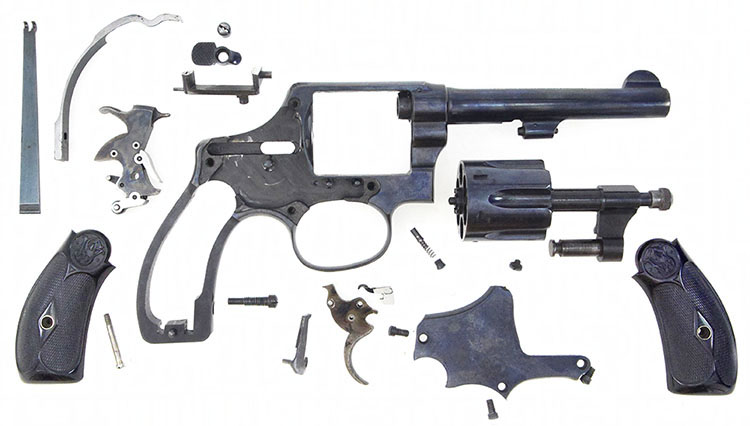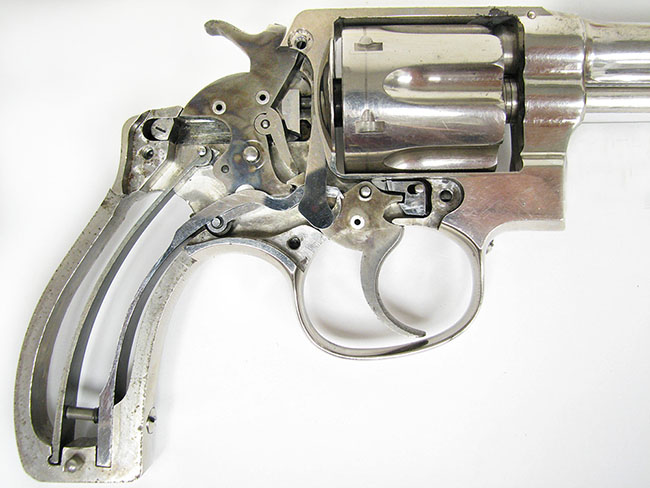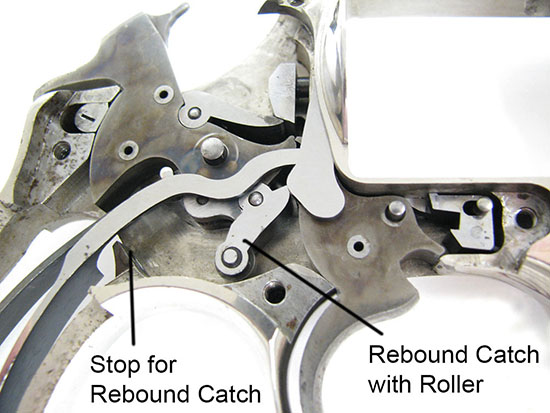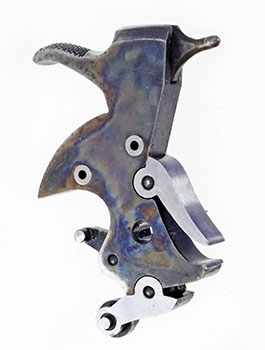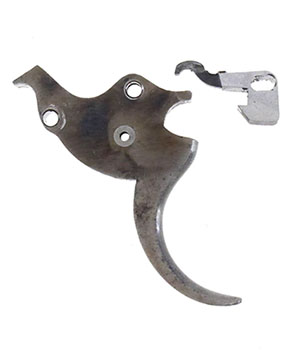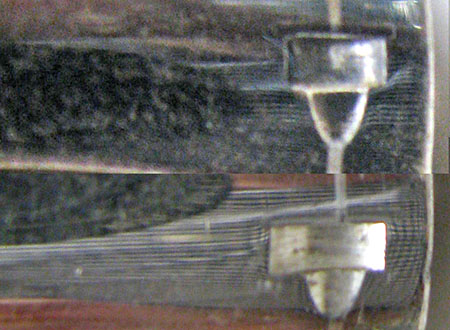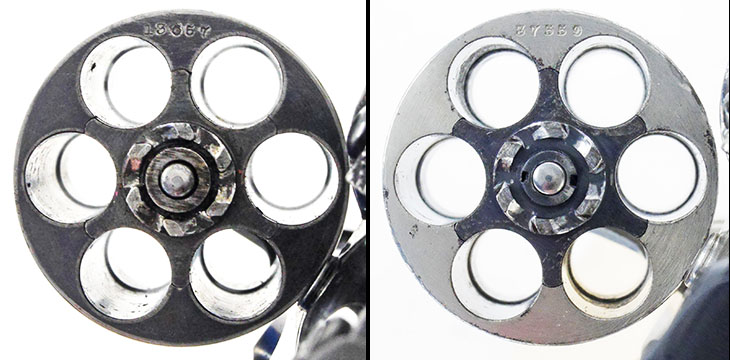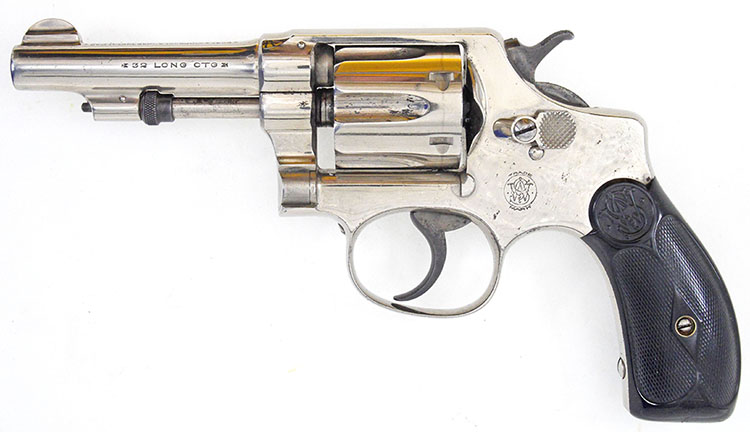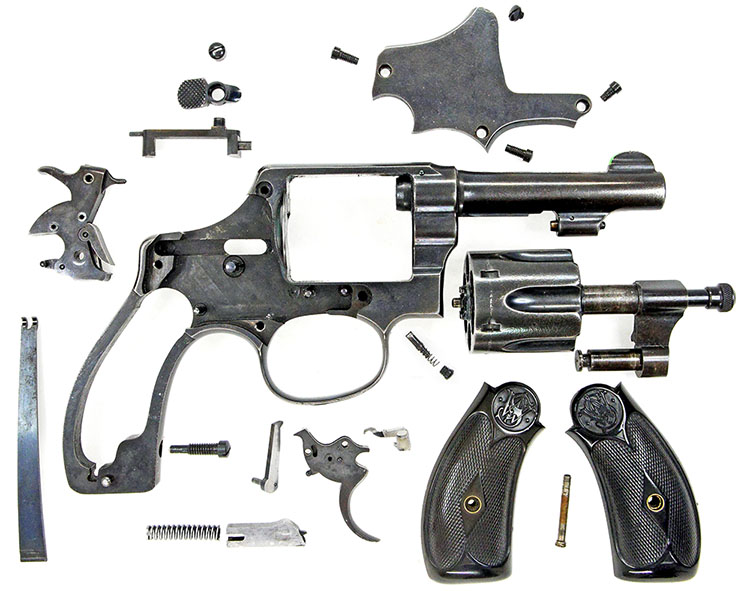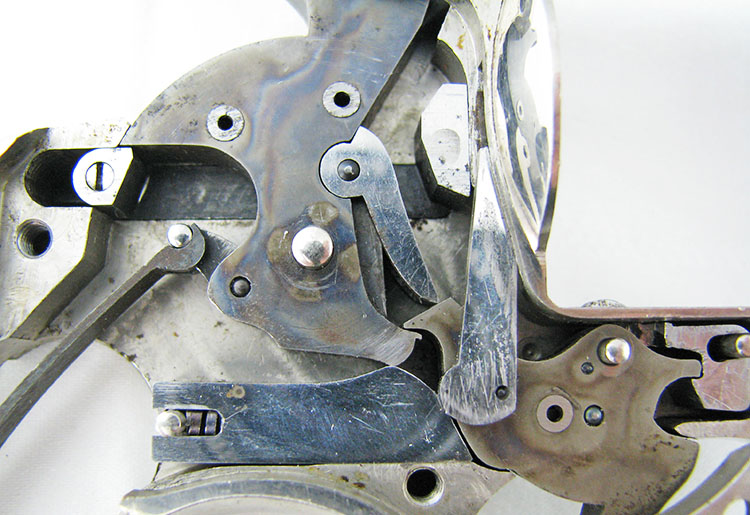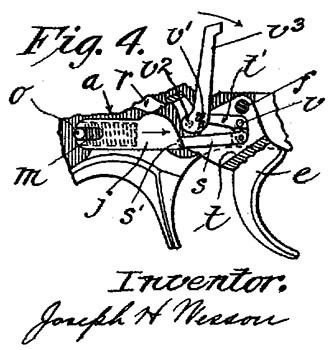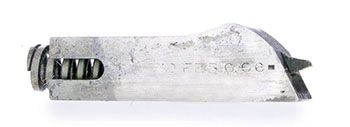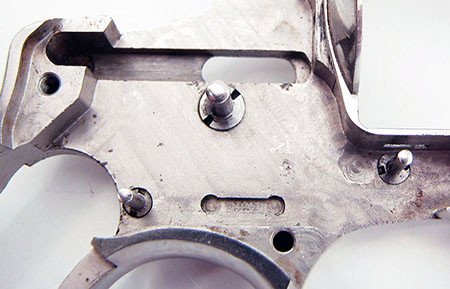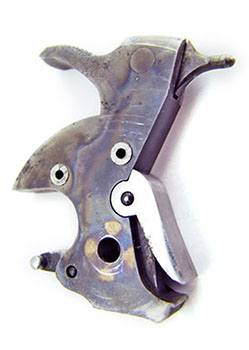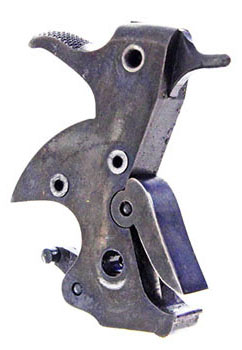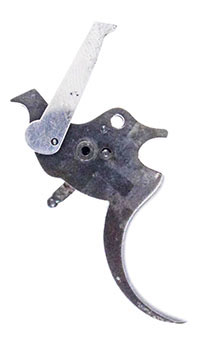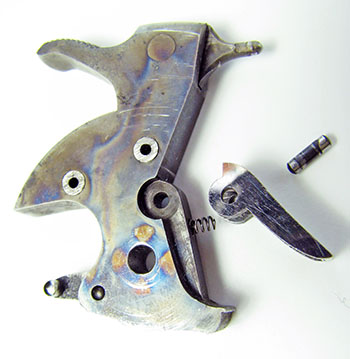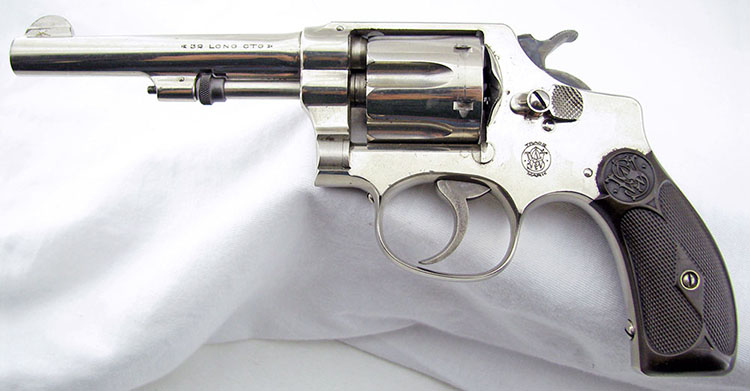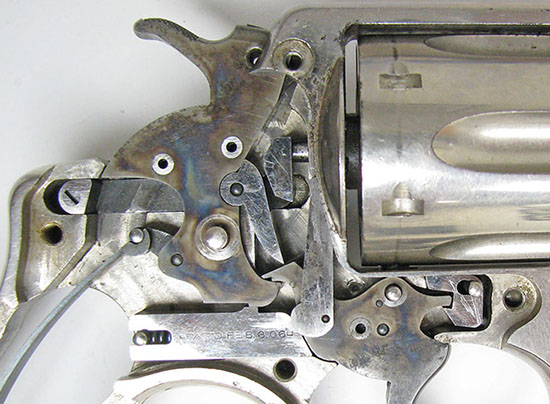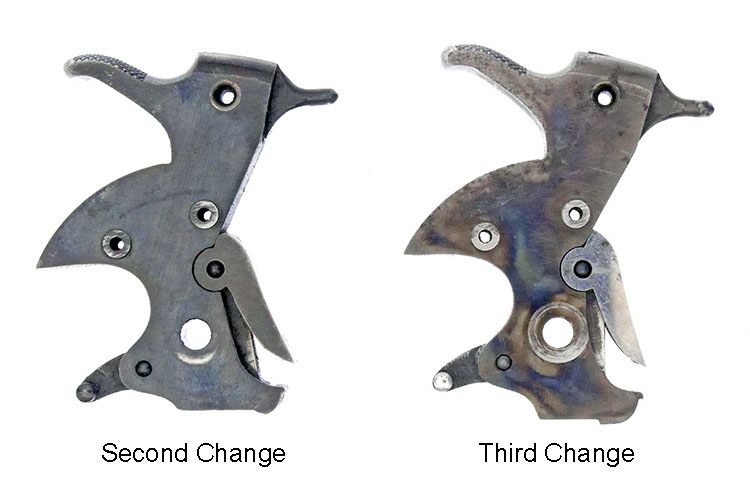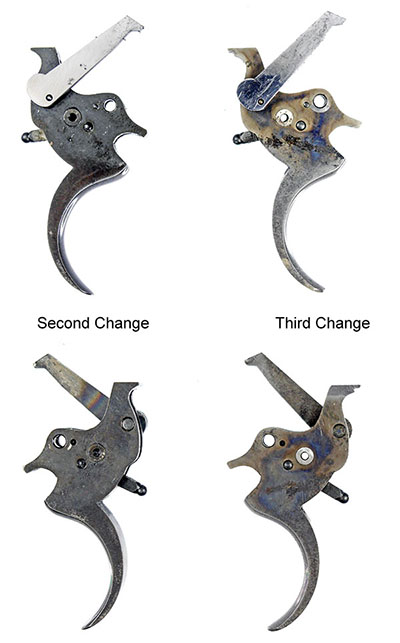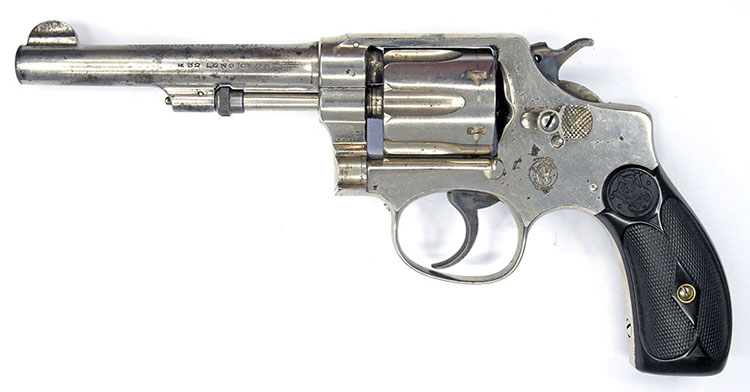 |
||||||||||||||||||||||||||||||||||||||||||||||||||||||||||||||||||||||||||||||||||||||||||||||||||||||||||||||||||||||||||||||||||||||||||||||||||||||||||||||||||||||||||||||||||||||||||||||||||||||||||||||||||||||||||||||||||||||||||||||||||||||||||||||||||||||||||||||||||||||||||||||||||||||||||||||||||||||||||||||||||||||||||||||||||||||||||||||||||||||||||||||||||||||||||||||||||||||||||||||||||||||||||||||||||||||||||||||||||||||||||||||||||||||||||||||||||||||||
|
The 1903 Smith & Wesson .32 Hand Ejector— Part 2—First, Second and Third Change by Ed Buffaloe and Gaston Comeau
Periodic changes were made to the lockwork of the Model 1903 .32 Smith & Wesson Hand Ejector in an effort to produce a lighter and smoother double action trigger pull. The First Change revolver is externally identical to the No Change version, except for a few minor differences in markings. Smith & Wesson manufactured about 31,700 First Change revolvers over a two year period before the next major revision.
First Change Lockwork The most obvious and important innovation in the Model 1903 First Change is a roller added to the end of the rebound catch. This roller is almost unknown in the Smith & Wesson literature. It is easily overlooked because it was only made for two years. McHenry & Roper state: “Rebound Catch—Slotted to use a roll instead of plain surface at contact point with frame to reduce friction upon recovery.” Neal & Jinks do not mention the roller but clearly take their wording from the earlier book: “[t]he shape of the rebound catch was changed where it contacts the frame to reduce friction on recovery.” To be fair, the rebound mechanism is partially hidden behind the trigger spring, its conformation not fully apparent until the spring is removed or the hammer is cocked. McHenry & Roper only mention it in the one brief sentence near the end of their book.
On the earlier Model 1903 (No Change) revolver, the rebound catch can bind against the stop during rapid double action fire. The roller on the First Change rebound catch prevents any such binding.
We have not located a parts list showing the rebound catch with roller, so it is no wonder this unusual feature is little known, but we have observed the roller in all First Change revolvers examined (between serial numbers 25,593 through 45,993) and it is briefly documented by McHenry & Roper. Smith & Wesson issued a parts list with the subtitle “Models 1903 and 1903 1st change” but it is identical to the 1903 parts list, except for the subtitle, and does not show the updated rebound catch with roller.
The trigger and cylinder stop are very closely fitted; we usually find it simpler to remove and install them as a unit. An elongated hole for the frame stud allows the stop to reciprocate backward and forward. The stop body is significantly smaller, with the spring and plunger that tension the stop moved into the frame, secured by a screw just above the bow of the trigger guard. The pin on the side of the stop is replaced with a broad slot above a beveled base. When the hammer is cocked or the trigger is pulled, the trigger hook, acting on the slot, pulls the stop down, out of engagement with the cylinder, to allow the hand to turn the cylinder. When the trigger hook moves below the slot, the stop snaps back up to lock the cylinder in the next notch. As the trigger rotates back to its normal position after firing, the hook acts against the bevel to cam the stop body forward. The trigger hook moves upward against the bevel, and the stop snaps back in place to re-engage the hook. The basic functionality of trigger hook and cylinder stop remains the same in modern Smith & Wesson revolvers. In the First Change revolver, the chafing pins in the hammer and trigger are replaced by bushings. Neal & Jinks also report: “At about serial number 48,000 the hammer nose rivet was changed from solid to hollow with expanded ends.” Possibly the change was implemented irregularly, because we have not observed the hollow hammer nose pin until the Second Change. Cylinder, Yoke, and Hand Slot As reported by McHenry & Roper, as well as Neal & Jinks, the reciprocating action of the cylinder stop requires a slightly longer slot in the bottom of the frame as well as slightly longer notches in the cylinder. We were unable to measure the length of the slot in the bottom of the frame using a micrometer, due to the limited space, but a small metal rule allowed us to estimate that the slot was lengthened by about 5/100ths of an inch (1.27 mm). The difference in the cylinder notch length is also difficult to measure with any accuracy, but can be seen in a photograph, and is very likely the same as the difference in the slot. The cylinder notches continue to be reinforced with hardened steel shims. While we had the micrometer out, we also measured the height of the hand slot and found a significant difference: Serial number 42 has a hand slot .318 inches in height (8.07 mm), whereas serial number 37559 has a hand slot .336 inches in height (8.54 mm).
McHenry & Roper report: “[d]iameter of bushing hole for center pin reduced, making head of center pin a like diameter [and] eliminating shoulder”, while Neal & Jinks report that “[t]he shoulder was removed from the extractor rod and the diameter of the extractor rod bushing hole was reduced.” Neal & Jinks appear to have conflated the center pin with the extractor rod: it was the center pin diameter that was changed. The serial number 13657 (No Change) cylinder center pin measures .122 inches in diameter (.3098 mm), whereas the serial number 37559 (First Change) cylinder center pin measures .119 inches in diameter (.3022 mm). So the diameter was reduced by .003 inch or about .076 mm, and the bushing that surrounds the pin was also reduced in size. The serial number 13657 bushing is .237 inches in diameter (6.03mm), whereas the serial number 37559 bushing is .204 inches in diameter ( 5.18mm).
The yoke stop is omitted in the First Change, and in subsequent, Model 1903 revolvers. Inscriptions and Grip Stocks The left side of the barrel is marked in upper case sans serif characters: 32 LONG CTG The inscription on top of the barrel is identical to that on late No Change guns; two 4¼ inch barrel examples (serial numbers 22085 and 25593) have their inscription on four lines in all upper case sans serif characters, as follows: SMITH&WESSON SPRINGFIELD MASS. U.S.A. Two later examples (serial numbers 46848 and 46880) omit the 1895 patent date and the Oct. 4, 1898 patent date; the 3¼ inch and 4¼ inch barrels have an inscription on four lines in upper case sans serif characters, as follows: SMITH&WESSON SPRINGFIELD MASS. U.S.A.
The small Smith & Wesson monogram is moved to the left side of the frame. Grip stocks remain the same as on earlier models. Walnut target stocks are available as a catalog option with the First Change but are rarely observed.
The 1903 Hand Ejector Second Change, in its earliest iteration, is externally identical to the First Change, right down to the inscription on top of the barrel. But the lockwork inside the gun has been transformed. Approximately 44,373 of the Second change were made over a three year period.
The Rebound Slide Because the rebounding of the hammer is necessarily related to trigger position, the mechanism is always powered by the trigger spring and is closely involved with the smoothness and weight of the trigger pull. Between 1894 and 1906 Daniel B. and/or Joseph H. Wesson were granted at least eight patents related to rebound mechanisms for revolvers.
Joe Wesson filed two patents on 11 July 1905, both for differing rebound mechanisms, one of which, U.S. Patent № 811807, was granted on 6 February 1906. The mechanism was described in the patent as “...a sliding wedge-like member in the frame which is connected by suitable means with the trigger, whereby when the trigger is released after the fall of the hammer a suitable spring associated with this sliding member operates to swing the trigger forward to normal position and simultaneously to retract the hammer by pushing said wedge-like member under the lower end thereof..., which operates to retract the upper end of the hammer and to hold it in retracted position.” This “sliding wedge-like member” became known as the “rebound slide” and has been used in Smith & Wesson revolvers ever since.
The raised surface at the top of the rebound slide engages the foot of the hammer, preventing the hammer nose (firing pin) from touching the cartridge primer. The slot at the rear of the rebound slide allows motion of the slide against a stud in the frame and also aids in installation by allowing the spring to be compressed using the blade of a screwdriver. The oval depression at the front of the slide engages the trigger lever, and the point above the depression prevents the lever from slipping out of engagement. The rebound spring is also the trigger spring. Note that the rebound spring is wound from square steel wire.
There is a slight relief cut in the frame beneath the rear half of the rebound slide to reduce friction and possibly allow room for lubricant (see Lockwork Detail photograph). Early rebound slides have a raised key on the back which runs in a slot milled in the frame. In late guns, the key and slot are eliminated. Late rebound slides are also stamped with the patent date: PAT’D. FEB. 6. 06.
Second Change Lockwork The trigger and hammer are both modified to work with the new rebound slide. The trigger has a vertically rotating square lever (or plunger) extending out the rear that engages an oval depression in the front of the rebound slide so that, when the trigger is pulled, it pushes the rebound slide backward, disengaging it from the foot of the hammer. An internal lever and spring are added to the trigger to tension the hand (see patent drawing above).
The hammer no longer requires the rebound catch that was attached to its base in the No Change and First Change revolvers; the rebound catch is replaced by the rebound slide. A small projection is added to the base of the hammer to engage with the rebound slide. The solid pin for the hammer nose (firing pin) in the early hammer is eliminated in late hammers and replaced with a hollow pin; this change may have taken place gradually, as Neal & Jinks report it in the First Change, though we have not observed it there.
A rib is added to the hammer body beneath the double action sear, and the sear has an appropriate opening underneath to fit over the rib. McHenry & Roper comment: “Rib added at sear cut from joint to foot strengthening hammer when rebounded.” This explanation is echoed by Neal & Jinks who simply say the rib is to “add strength”. Inscriptions and Grip Stocks The left side of the barrel is marked in upper case sans serif characters: 32 LONG CTG The early four line inscription (serial number 59273 and 65113) is identical to that on First Change guns; the inscription is in upper case sans serif characters, as follows: SMITH&WESSON SPRINGFIELD MASS. U.S.A. The late four line inscription (serial number 87874) excludes some earlier patents while including the 1906 patent date for the rebound slide; the inscription is in upper case sans serif characters, as follows: SMITH&WESSON SPRINGFIELD MASS. U.S.A.
Neal & Jinks state: “Near the end of production of this model [Second Change] the use of hardened steel shims in the cylinder stop notches was discontinued.” This would have considerably simplified cylinder production, as installation of the shims was an elaborate, time consuming, and expensive six step process. Heat treating the entire cylinder was a considerably faster and cheaper method. Grip stocks remain the same as on earlier models, of checked hard rubber with the S&W Monogram in a circle at the top.
This is the rarest of all the changes, with only 625 produced. The Third Change is externally identical to the Second Change. The Third Change represents incremental improvements to the hammer, trigger , and rebound slide, none of which are interchangeable with their Second Change counterparts. We could detect no modification of the frame. Lockwork
The photograph above shows the axis holes on the same plane, so we can see that the base of the Third Change hammer extends lower than that of the Second. The angle of the lower portion of the foot of the hammer is steeper on the Third Change. The length of the double action sear on the Third Change is about 1/32 inch shorter than that of the Second Change, but the altered geometry of the hammer means that the end of the sear is in about the same position as that on the Second Change.
The trigger on the Third Change is largely the same except for the rear nose, which is extended slightly to engage the shortened double action sear. The full cock notch is located beneath the lip of the nose. Neal & Jinks comment: “The trigger and sear were... changed to obtain a greater double action throw.” Though it is difficult to accurately measure the distance of the hammer throw, the extended cocking lever gives it slightly more leverage when it engages the sear. There are no changes to the hand or cylinder stop.
The rebound slide on the Third Change is not quite so tall and is configured with a flat surface to engage properly with the new hammer. The coil spring is now made from round wire. Inscription A four line inscription (serial number 95745) is identical to that on Second Change revolvers, in upper case sans serif characters, as follows: SMITH&WESSON SPRINGFIELD MASS. U.S.A.
Part 1: Model 1903 Introduction and No Change Part 3: Model 1903 Fourth, Fifth, Sixth Change, and Regulation Police |
||||||||||||||||||||||||||||||||||||||||||||||||||||||||||||||||||||||||||||||||||||||||||||||||||||||||||||||||||||||||||||||||||||||||||||||||||||||||||||||||||||||||||||||||||||||||||||||||||||||||||||||||||||||||||||||||||||||||||||||||||||||||||||||||||||||||||||||||||||||||||||||||||||||||||||||||||||||||||||||||||||||||||||||||||||||||||||||||||||||||||||||||||||||||||||||||||||||||||||||||||||||||||||||||||||||||||||||||||||||||||||||||||||||||||||||||||||||||
|
||||||||||||||||||||||||||||||||||||||||||||||||||||||||||||||||||||||||||||||||||||||||||||||||||||||||||||||||||||||||||||||||||||||||||||||||||||||||||||||||||||||||||||||||||||||||||||||||||||||||||||||||||||||||||||||||||||||||||||||||||||||||||||||||||||||||||||||||||||||||||||||||||||||||||||||||||||||||||||||||||||||||||||||||||||||||||||||||||||||||||||||||||||||||||||||||||||||||||||||||||||||||||||||||||||||||||||||||||||||||||||||||||||||||||||||||||||||||
|
Copyright 2024 by Ed Buffaloe and Gaston Comeau. All rights reserved. |
||||||||||||||||||||||||||||||||||||||||||||||||||||||||||||||||||||||||||||||||||||||||||||||||||||||||||||||||||||||||||||||||||||||||||||||||||||||||||||||||||||||||||||||||||||||||||||||||||||||||||||||||||||||||||||||||||||||||||||||||||||||||||||||||||||||||||||||||||||||||||||||||||||||||||||||||||||||||||||||||||||||||||||||||||||||||||||||||||||||||||||||||||||||||||||||||||||||||||||||||||||||||||||||||||||||||||||||||||||||||||||||||||||||||||||||||||||||||
|
|
||||||||||||||||||||||||||||||||||||||||||||||||||||||||||||||||||||||||||||||||||||||||||||||||||||||||||||||||||||||||||||||||||||||||||||||||||||||||||||||||||||||||||||||||||||||||||||||||||||||||||||||||||||||||||||||||||||||||||||||||||||||||||||||||||||||||||||||||||||||||||||||||||||||||||||||||||||||||||||||||||||||||||||||||||||||||||||||||||||||||||||||||||||||||||||||||||||||||||||||||||||||||||||||||||||||||||||||||||||||||||||||||||||||||||||||||||||||||
